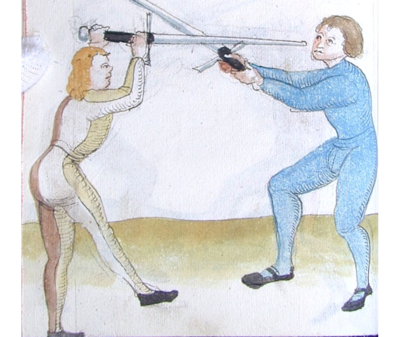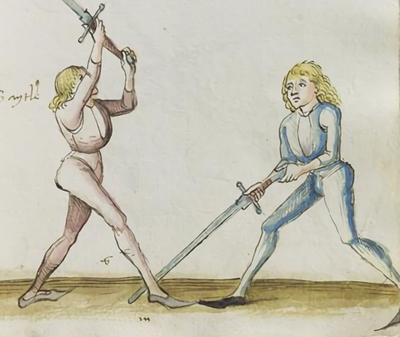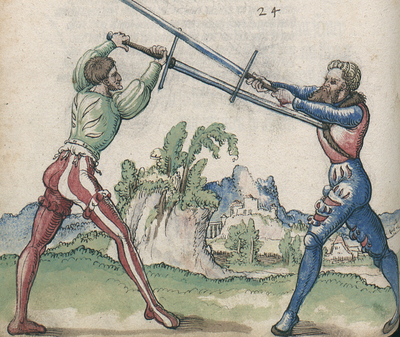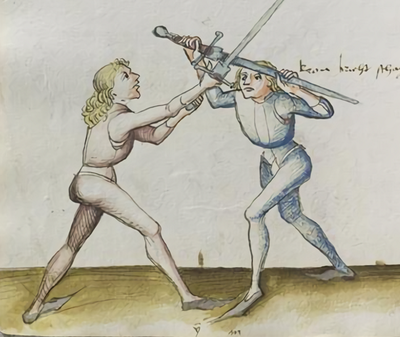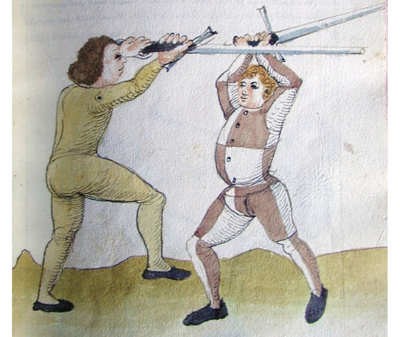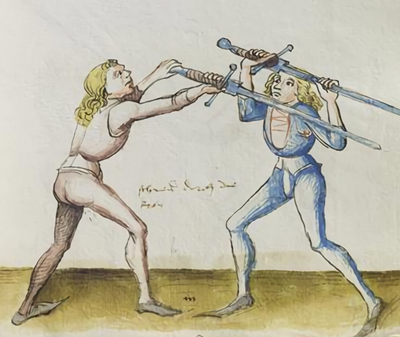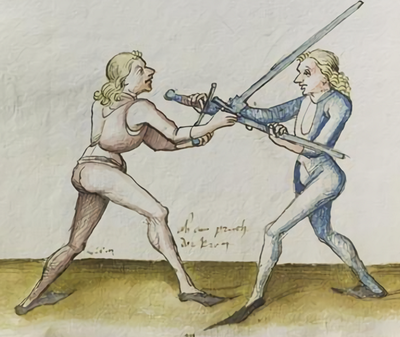|
|
You are not currently logged in. Are you accessing the unsecure (http) portal? Click here to switch to the secure portal. |
Difference between revisions of "Case Study:Schaydelhaw"
m (Michael Chidester moved page User talk:Michael Chidester/Schaydelhaw to Case Study:Schaydelhaw) |
|||
| (7 intermediate revisions by the same user not shown) | |||
| Line 1: | Line 1: | ||
| − | <div style="width: | + | {{TOC right}} |
| − | {| class="master | + | Only two members of the [[Fellowship of Liechtenauer]] are known to have taught the unarmored fencing according to [[Johannes Liechtenauer]]'s [[Recital]] on the Long Sword, namely [[Sigmund ain Ringeck]] and [[Hans Seydenfaden von Erfurt]]. |
| + | |||
| + | Here is a side-by-side comparison of the [[gloss]]es on only section of the Recital that we have in its entirety from both, the [[Scheitelhaw]]. Also included are illustrations from three manuscripts related to the texts. | ||
| + | |||
| + | This comparison is intended to demonstrate how masters from the same lineage and even the same teacher might present different interpretations of their tradition. | ||
| + | |||
| + | == Text == | ||
| + | |||
| + | <div style="width:120em;"> | ||
| + | {| class="master" | ||
|- | |- | ||
! <p>Images<br/>from Glasgow and Goliath</p> | ! <p>Images<br/>from Glasgow and Goliath</p> | ||
| Line 8: | Line 17: | ||
|- | |- | ||
| − | | [[File:MS E.1939.65.341 007v-detail.png| | + | | [[File:MS E.1939.65.341 007v-detail.png|400x400px|center|border]] |
| − | | <p> | + | | <p>{{red|b=1|This is the text and the gloss about the parter, and about the plays thereof}}</p> |
{| class="zettel" | {| class="zettel" | ||
|- | |- | ||
| <small>63</small> | | <small>63</small> | ||
| − | | The Parter<br/> Is a danger to the face. | + | | ''The Parter<br/> Is a danger to the face.'' |
|- | |- | ||
| <small>64</small> | | <small>64</small> | ||
| − | | With its turn<ref>''Kehr'' has two etymologies: one is "to turn", the other is "to sweep away" or to "carry off"; the gloss supports the first derivation.</ref><br/> The chest is quickly<ref name="fast">Alternately: strongly, firmly, steadfastly.</ref> threatened. | + | | ''With its turn<ref>''Kehr'' has two etymologies: one is "to turn", the other is "to sweep away" or to "carry off"; the gloss supports the first derivation.</ref><br/> The chest is quickly<ref name="fast">Alternately: strongly, firmly, steadfastly.</ref> threatened.'' |
|} | |} | ||
| − | <p>{{red|b=1|Gloss}}. Here note the parter is really dangerous to the face and to the chest; deploy it thusly: When he stands against you in the guard [of] the fool, hew above with the long edge, down from your<ref>D. ''der lange'': "long, high, tall, or lofty".</ref> part to his head, and with the hew remain high with the arms and if he displaces, so hang-in<ref>''einhangen'': to adhere, stick to, cleave to, hold on to, engage deeply.</ref> to him with the point, with the long edge above his hilt, and thrust him to the face (as stands pictured | + | <p>{{red|b=1|Gloss}}. Here note the parter is really dangerous to the face and to the chest; deploy it thusly: When he stands against you in the guard [of] the fool, hew above with the long edge, down from your<ref>D. ''der lange'': "long, high, tall, or lofty".</ref> part to his head, and with the hew remain high with the arms and if he displaces, so hang-in<ref>''einhangen'': to adhere, stick to, cleave to, hold on to, engage deeply.</ref> to him with the point, with the long edge above his hilt, and thrust him to the face (as stands pictured next to this).</p> |
| − | | [[File:MS CL23842 027r-detail.png| | + | | [[File:MS CL23842 027r-detail.png|400x400px|center|border]] |
| − | | <p>'''The squinter with scalper with | + | | <p>'''The squinter with scalper with its plays'''<br/><br/></p> |
{| class="zettel" | {| class="zettel" | ||
|- | |- | ||
| <small>63</small> | | <small>63</small> | ||
| − | | ''The scalper <br/>  | + | | ''The scalper<br/> Is a threat to the face.'' |
|- | |- | ||
| <small>64</small> | | <small>64</small> | ||
| − | | ''With | + | | ''With its turn,<br/> The chest is quickly<ref name="fast"/> threatened.'' |
|} | |} | ||
<p>'''Gloss''': Initiate a hew straight above from the top of the head with the long edge, and swiftly upon that, an under-hew to the right side of his head. Thereafter according to the two plays in his school rules with other strikes, treads and deception.</p> | <p>'''Gloss''': Initiate a hew straight above from the top of the head with the long edge, and swiftly upon that, an under-hew to the right side of his head. Thereafter according to the two plays in his school rules with other strikes, treads and deception.</p> | ||
|- | |- | ||
| − | + | | [[File:MS Germ.Quart.2020 038v-detail.png|400x400px|center|border]] | |
| − | + | | <p>Item. If he then shoves the point firmly upward with his hilt in the displacement of the parter, invert your sword with the hilt high<ref>S. ''fast vber sich'': "firmly upward".</ref> in front of your head (such that the thumb comes below), and set the point under his hands upon his chest (as stands pictured here).</p> | |
| − | |||
| − | | [[File:MS Germ.Quart.2020 038v-detail.png| | ||
| − | | <p>If he then shoves the point firmly upward with his hilt in the displacement of the parter, invert your sword with the hilt high<ref>S. ''fast vber sich'': "firmly upward".</ref> in front of your head (such that the thumb comes below), and set the point under his hands upon his chest (as stands pictured here).</p> | ||
| | | | ||
| | | | ||
| − | |||
| − | |||
| − | |||
|- | |- | ||
| | | | ||
| − | | <p> | + | | <p>{{red|b=1|How the crown breaks the parter}}</p> |
{| class="zettel" | {| class="zettel" | ||
|- | |- | ||
| <small>65</small> | | <small>65</small> | ||
| − | | Whatever comes from him,<br/> The crown takes it away. | + | | ''Whatever comes from him,<br/> The crown takes it away.'' |
|} | |} | ||
<p>{{red|b=1|Gloss}}. Note, when you cleave-in above with the parter: if he displaces with the hilt high over his head, this displacement is called the crown, and with it [he] runs-in to you.</p> | <p>{{red|b=1|Gloss}}. Note, when you cleave-in above with the parter: if he displaces with the hilt high over his head, this displacement is called the crown, and with it [he] runs-in to you.</p> | ||
| − | | [[File:MS CL23842 027v-detail.png| | + | | [[File:MS CL23842 027v-detail.png|400x400px|center|border]] |
| <p>'''Another play. How the crown breaks the scalper.'''</p> | | <p>'''Another play. How the crown breaks the scalper.'''</p> | ||
{| class="zettel" | {| class="zettel" | ||
|- | |- | ||
| <small>65</small> | | <small>65</small> | ||
| − | | ''What comes from him, <br/>  | + | | ''What comes from him,<br/> The crown takes away.'' |
|} | |} | ||
<p>'''Gloss''': When you hew-in above with the scalper, if he then displaces high with the sword athwart over the head or gripped with an armored hand, that is called the crown against Seydenfaden's scalper, and with that run-in with shoving, etc. It also takes-off the scalper. This also breaks someone like this again as above with the hilt thrown over that and cast down.</p> | <p>'''Gloss''': When you hew-in above with the scalper, if he then displaces high with the sword athwart over the head or gripped with an armored hand, that is called the crown against Seydenfaden's scalper, and with that run-in with shoving, etc. It also takes-off the scalper. This also breaks someone like this again as above with the hilt thrown over that and cast down.</p> | ||
|- | |- | ||
| − | + | | [[File:MS E.1939.65.341 009r-detail.png|400x400px|center|border]] | |
| − | + | | <p>{{red|b=1|This is the text and the gloss: how the cut breaks the crown}}</p> | |
| − | |||
| − | | [[File:MS E.1939.65.341 009r-detail.png| | ||
| − | | <p> | ||
{| class="zettel" | {| class="zettel" | ||
|- | |- | ||
| <small>66</small> | | <small>66</small> | ||
| − | | Cut through the crown,<br/> So you break the hard beautifully;<ref>D., G. ''Schon'', lit. "already", "yet".</ref> | + | | ''Cut through the crown,<br/> So you break the hard beautifully;''<ref>D., G. ''Schon'', lit. "already", "yet".</ref> |
|- | |- | ||
| <small>67</small> | | <small>67</small> | ||
| − | | Press the strike,<ref>D. ''stuch'', R. ''stich'': "press the thrust".</ref><br/> Withdraw it with cutting. | + | | ''Press the strike,<ref>D. ''stuch'', R. ''stich'': "press the thrust".</ref><br/> Withdraw it with cutting.'' |
|} | |} | ||
<p>{{red|b=1|Gloss}}. Note, when he displaces the parter (or otherwise another hew) with the crown and with that runs in: so take the under-cut below his hands into his arm and press firmly upwards (as stands pictured next to this); so the crown is well broken...</p> | <p>{{red|b=1|Gloss}}. Note, when he displaces the parter (or otherwise another hew) with the crown and with that runs in: so take the under-cut below his hands into his arm and press firmly upwards (as stands pictured next to this); so the crown is well broken...</p> | ||
| − | | [[File:MS CL23842 028r-detail.png| | + | | [[File:MS CL23842 028r-detail.png|400x400px|center|border]] |
| <p>'''Another play. How the cut breaks the crown.'''<br/><br/></p> | | <p>'''Another play. How the cut breaks the crown.'''<br/><br/></p> | ||
{| class="zettel" | {| class="zettel" | ||
|- | |- | ||
| <small>66</small> | | <small>66</small> | ||
| − | | ''Cut through the crown, <br/>  | + | | ''Cut through the crown,<br/> So you break the hard beautifully.'' |
|- | |- | ||
| <small>67</small> | | <small>67</small> | ||
| − | | ''Press the strike. <br/> It backs-off with cutting.'' | + | | ''Press the strike.<br/> It backs-off with cutting.'' |
|} | |} | ||
<p>'''Gloss''': When he displaces the scalper (or otherwise a hew) with the armed crown and with that runs-in, then take the cut under his hands, into his arms and press firmly upward...</p> | <p>'''Gloss''': When he displaces the scalper (or otherwise a hew) with the armed crown and with that runs-in, then take the cut under his hands, into his arms and press firmly upward...</p> | ||
| − | |||
| − | |||
| − | |||
|- | |- | ||
| | | | ||
| <p>...and wind your sword from the under-cut into the over-cut, and with that withdraw yourself.</p> | | <p>...and wind your sword from the under-cut into the over-cut, and with that withdraw yourself.</p> | ||
| − | | [[File:MS CL23842 028v-detail.png| | + | | [[File:MS CL23842 028v-detail.png|400x400px|center|border]] |
| <p>...and with the stroke back yourself off with it.</p> | | <p>...and with the stroke back yourself off with it.</p> | ||
|} | |} | ||
</div> | </div> | ||
| + | |||
| + | == Notes == | ||
| + | |||
| + | {{reflist}} | ||
Latest revision as of 02:56, 4 June 2020
Only two members of the Fellowship of Liechtenauer are known to have taught the unarmored fencing according to Johannes Liechtenauer's Recital on the Long Sword, namely Sigmund ain Ringeck and Hans Seydenfaden von Erfurt.
Here is a side-by-side comparison of the glosses on only section of the Recital that we have in its entirety from both, the Scheitelhaw. Also included are illustrations from three manuscripts related to the texts.
This comparison is intended to demonstrate how masters from the same lineage and even the same teacher might present different interpretations of their tradition.
Text
Images |
Images |
||||||||||
|---|---|---|---|---|---|---|---|---|---|---|---|
This is the text and the gloss about the parter, and about the plays thereof
Gloss. Here note the parter is really dangerous to the face and to the chest; deploy it thusly: When he stands against you in the guard [of] the fool, hew above with the long edge, down from your[3] part to his head, and with the hew remain high with the arms and if he displaces, so hang-in[4] to him with the point, with the long edge above his hilt, and thrust him to the face (as stands pictured next to this). |
The squinter with scalper with its plays
Gloss: Initiate a hew straight above from the top of the head with the long edge, and swiftly upon that, an under-hew to the right side of his head. Thereafter according to the two plays in his school rules with other strikes, treads and deception. | ||||||||||
Item. If he then shoves the point firmly upward with his hilt in the displacement of the parter, invert your sword with the hilt high[5] in front of your head (such that the thumb comes below), and set the point under his hands upon his chest (as stands pictured here). |
|||||||||||
How the crown breaks the parter
Gloss. Note, when you cleave-in above with the parter: if he displaces with the hilt high over his head, this displacement is called the crown, and with it [he] runs-in to you. |
Another play. How the crown breaks the scalper.
Gloss: When you hew-in above with the scalper, if he then displaces high with the sword athwart over the head or gripped with an armored hand, that is called the crown against Seydenfaden's scalper, and with that run-in with shoving, etc. It also takes-off the scalper. This also breaks someone like this again as above with the hilt thrown over that and cast down. | ||||||||||
This is the text and the gloss: how the cut breaks the crown
Gloss. Note, when he displaces the parter (or otherwise another hew) with the crown and with that runs in: so take the under-cut below his hands into his arm and press firmly upwards (as stands pictured next to this); so the crown is well broken... |
Another play. How the cut breaks the crown.
Gloss: When he displaces the scalper (or otherwise a hew) with the armed crown and with that runs-in, then take the cut under his hands, into his arms and press firmly upward... | ||||||||||
...and wind your sword from the under-cut into the over-cut, and with that withdraw yourself. |
...and with the stroke back yourself off with it. |
Notes
- ↑ Kehr has two etymologies: one is "to turn", the other is "to sweep away" or to "carry off"; the gloss supports the first derivation.
- ↑ 2.0 2.1 Alternately: strongly, firmly, steadfastly.
- ↑ D. der lange: "long, high, tall, or lofty".
- ↑ einhangen: to adhere, stick to, cleave to, hold on to, engage deeply.
- ↑ S. fast vber sich: "firmly upward".
- ↑ D., G. Schon, lit. "already", "yet".
- ↑ D. stuch, R. stich: "press the thrust".

